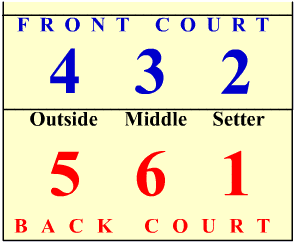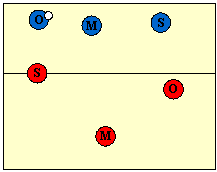
When you played volleyball in school you probably played with 3 people in a line in the front and 3 in the back.On change of service you rotated clockwise but stayed where you were rotated to. There are several disadvantages with this system:
To continue the discussion, we need to know a bit about the nomenclature of positions :

There are 6 positions on the court - named 1 to 6. 1 is the server and the rest are numbered sequentially round the court anticlockwise. The number refers to position on court, not the player.
Positions 2,3 & 4 are front court players, 5,6 & 1 backcourt: to reiterate, only front court players can smash at the net.
The right side of the court (1 & 2) is usually where the setters try to end up: position 2 is the 'front court setter' and 1 the 'backcourt setter'. 3 & 6 are 'middle' players and 4 & 5 'outside' players
'============================================================ ' 1. NORMAL POSITIONS '============================================================As in squash, where you try to return to the T,in volleyball when the ball is passed over the net, you try to get back into your "normal" positions, so when the attack does come, you will be able to move to the appropriate position for that attack (see Receiving an attack).
Below are the normal positions and territories covered by back court players:

The arrows indicate the territories back court players generally cover. Note that the middle player covers the whole of the back line. The back-court setter and outside player's job is to pick up anything front court, e.g. tips and off the block. Anything that goes above their shoulders should be picked up by the back-court middle player.
You will see later, that depending where the attack is coming from, this formation will change, but the back court players' duties will remain roughly the same.
'============================================================ ' 2. RECEIVING ATTACK '============================================================We shall start with where you should be with different attacks to show why switching makes sense:
|
Attack from left |
|
|
|
Initial 'resting' position |
Attack from middle |
|
Attack from right |
|
As mentioned earlier, one of the reasons for having set positions is because only front court players can hit front court, so if we can get the back-court setter setting, he will have 3, rather than 2 players to set to. Obviously, if the back court setter receives the first ball, then he cannot dig it to himself, and in these situations you will only have a 2 man attack. If the back-court setter does not receive the first ball, he will be able to move forward to the front court, whilst the 'normal' setter can drop back and be the third attack.
 |
|
 |
|
 |
|
 |
|
 |
|
Basically, you need to start in your rotation, and as soon as the ball is served, rush to where you should be.
Start as close as possible to where you are going to end up (under constraints of rotation) - you will be ready to play the receive earlier, and you will be less knackered at the end of the match.
Below represents where and when you should be moving for different rotations.
|
 |
|
|
 |
Position to move to |
|
 |
Getting to the correct position after serving is a doddle, because you have time to switch just after the ball has been served.
Getting to the right position whilst you are receiving service is harder, because you has to see where the ball is going, play it if necessary, then move to the right position, ever mindful that the opposition might chuck it back as you are moving into position.
Below represents where and when you should be moving for different rotations.
|
Service Receive Rotations 1 and 4
|
|
 |
|
 |
|
 |
|
 |
|
 |
|
|
Service Receive Rotations 2 and 5
(penetrating setter)
|
|
 |
|
 |
|
 |
|
 |
|
 |
|
|
Service Receive Rotations 3 and 6
(middles)
|
|
 |
|
 |
|
 |
|
 |
|
 |
|